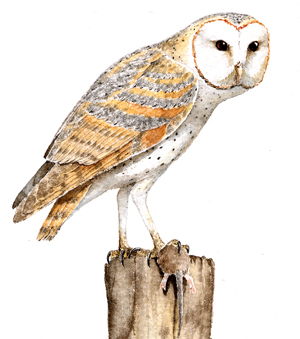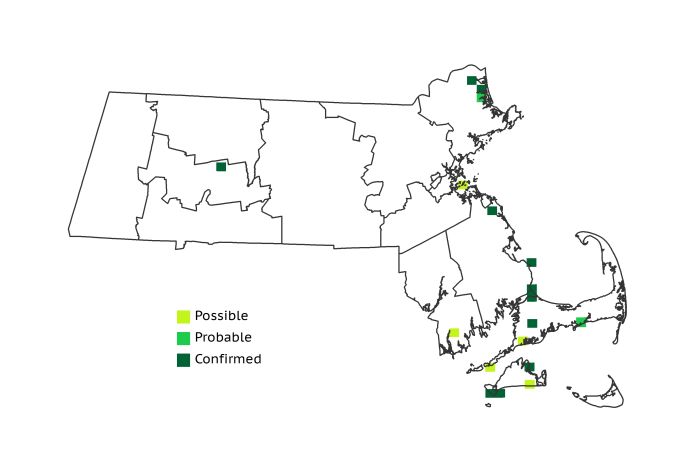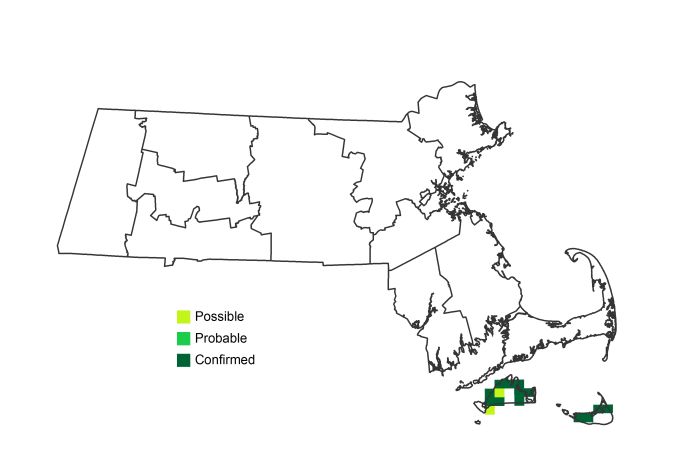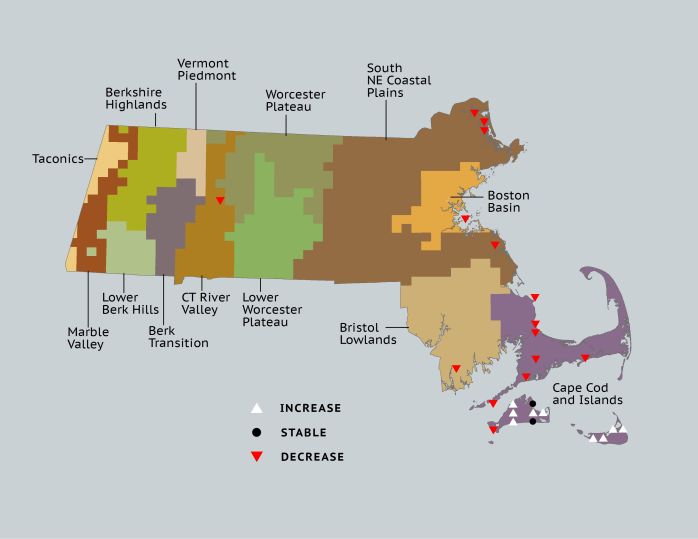Breeding Bird Atlases (BBA)
Find a Bird
Barn Owl
Tyto alba

Very local and strongly declining
Conservation action urgent
Species of Special Concern

“It was the owl that shrieked, the fatal bellman, / Which gives the stern’st good-night.” – William Shakespeare, Macbeth
The long-legged, monkey-faced Barn Owl is impossible to confuse with any of our other owl species, assuming that one is fortunate enough to see one in the first place. All owls have nocturnal tendencies, but the Barn Owl is one of the species least often seen abroad by day, though its unearthly shrieks can sometimes be heard in the late hours of the night. In Massachusetts, they typically hunt around open coastal marshes at night, while roosting in old barns and haylofts or natural tree cavities during the day. Loss of these hunting and roosting areas along with a rugged winter climate has made life doubly difficult for Barn Owls in Massachusetts.
Historic Status
Because of its deeply nocturnal behavior, the Barn Owl often escapes detection. Joel Asaph Allen reported only two sightings of the species in Massachusetts in his 1879 listing of the birds of the state: one in Lynn in 1865 and one in Springfield in 1868. Over the ensuing 50 years, Forbush believed that the species “increased very materially...but this may be due to the increased number of observers” (Forbush 1927). Between 1900 and 1927, Forbush registered 11 sightings or “takes” in Massachusetts, from Cape Cod and Martha's Vineyard to the Connecticut River Valley. In the eastern United States habitat changes have caused the Barn Owl’s distribution to ebb and flow since the beginning of European settlement, but Massachusetts has seemingly never been more than the extreme northeastern boundary of the range of this otherwise widely distributed species.
Atlas 1 Distribution
Barn Owls were fairly scattered and highly elusive during Atlas 1, but several blocks with breeding activity were reported. A single Confirmation in the Connecticut River Valley, nearly a hundred miles away from the next-closest block along the coast, may have represented the last gasp of a vanishing population in that region. Three occupied blocks in coastal Essex County and one on the South Shore typified the Barn Owl’s mostly coastal distribution for Atlas 1, as did a Possible block in Boston Harbor. The Bristol/Narragansett Lowlands had only one block showing detection, but Cape Cod and the Islands had more than all other regions combined. Barn Owl breeding activity was reported in 8% of the Cape and Islands ecoregion, with a particular aggregation on Martha’s Vineyard. The mild coastal climate was likely an important factor in the continued survival of this primarily southern species in these regions.
Atlas 2 Distribution and Change
Three decades later, this picture drew sharply into focus. Barn Owls completely retreated from the mainland to offshore enclaves on Nantucket and Martha’s Vineyard. Despite this shift in distribution, more Barn Owl nests were Confirmed in Atlas 2 than in Atlas 1. The species could persist for some time on the offshore islands so long as active efforts to maintain nesting structures continue, but the prospects for continued breeding on the mainland seem to be increasingly remote.
Atlas 1 Map

Atlas 2 Map

Atlas Change Map

Ecoregion Data
Atlas 1 | Atlas 2 | Change | ||||||
Ecoregion | # Blocks | % Blocks | % of Range | # Blocks | % Blocks | % of Range | Change in # Blocks | Change in % Blocks |
Taconic Mountains | 0 | 0.0 | 0.0 | 0 | 0.0 | 0.0 | 0 | 0.0 |
Marble Valleys/Housatonic Valley | 0 | 0.0 | 0.0 | 0 | 0.0 | 0.0 | 0 | 0.0 |
Berkshire Highlands | 0 | 0.0 | 0.0 | 0 | 0.0 | 0.0 | 0 | 0.0 |
Lower Berkshire Hills | 0 | 0.0 | 0.0 | 0 | 0.0 | 0.0 | 0 | 0.0 |
Vermont Piedmont | 0 | 0.0 | 0.0 | 0 | 0.0 | 0.0 | 0 | 0.0 |
Berkshire Transition | 0 | 0.0 | 0.0 | 0 | 0.0 | 0.0 | 0 | 0.0 |
Connecticut River Valley | 1 | 1.8 | 5.6 | 0 | 0.0 | 0.0 | -1 | -2.1 |
Worcester Plateau | 0 | 0.0 | 0.0 | 0 | 0.0 | 0.0 | 0 | 0.0 |
Lower Worcester Plateau | 0 | 0.0 | 0.0 | 0 | 0.0 | 0.0 | 0 | 0.0 |
S. New England Coastal Plains and Hills | 4 | 1.5 | 22.2 | 0 | 0.0 | 0.0 | -4 | -1.8 |
Boston Basin | 1 | 1.8 | 5.6 | 0 | 0.0 | 0.0 | -1 | -1.8 |
Bristol and Narragansett Lowlands | 1 | 0.9 | 5.6 | 0 | 0.0 | 0.0 | -1 | -1.0 |
Cape Cod and Islands | 11 | 8.1 | 61.1 | 15 | 10.4 | 100.0 | 1 | 0.8 |
Statewide Total | 18 | 1.9 | 100.0 | 15 | 1.4 | 100.0 | -6 | -0.7 |



